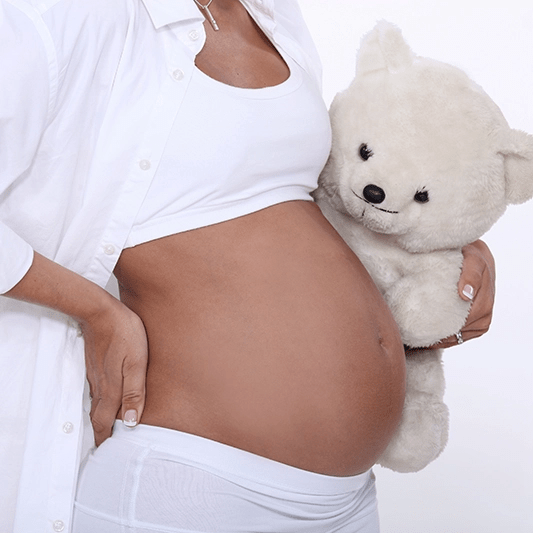Maternal Vaccine Effectiveness and Vaccine Strategies in the United States – Elizabeth P. Schlaudecker
Young, healthy pregnant women are susceptible to increased morbidity and mortality due to infectious diseases. With vaccination, a pregnant woman produces antibodies which gets to the baby through placental transfer and protect the young infant from infectious diseases. The ultimate goal is to protect mother, developing fetus and newborn infant. Pregnancy likely alters the immune response to both infection and vaccination. There are changes in T cell differentiation during pregnancy, including down-regulation of Th1, up-regulation of Th2 cells and changes in Th17 and regulatory cells, that may alter the response of vaccination. The 1918 influenza pandemic affected young people and pregnant people more than others, with birth depression that were consistent with first trimester miscarriages (approximately 1 out of 10 pregnant women). This reflects upon the alarming changes that occur with infection during pregnancy. Studies have shown increased influenza infection to be associated with decreased birth weight where 200 grams of birth weight difference was seen between influenza vaccinated and non-vaccinated pregnant women. Tetanus toxoid vaccine have been used for a long time to prevent neonatal tetanus. Pregnant women were prioritized to receive influenza vaccine in 1960 in the US and 43 million Americans were vaccinated against 1976 swine flu. A randomized study in Bangladesh in 2005 showed that maternal influenza immunization prevented influenza in infants and mothers. Breast milk secretory IgA in vaccinated mothers was significantly higher than in the control group, and exclusive breastfeeding in these individuals prevented respiratory illness with fever episodes in the infants. This protection was extended when the mothers continued to breastfeed past 6 months of age. A pooled analysis of trials in South Africa, Mali and Nepal showed continued protection against influenza after vaccination during pregnancy. The vaccine efficacy did not change depending on the time mother was vaccinated, but an improved efficacy was observed when mothers were vaccinated after 29 weeks. Influenza vaccine is safe in pregnant women as per GAIA (Global Alignment of Immunization safety Assessment in pregnancy) guidelines. Postpartum immunization with inactivated influenza vaccine (IIV) vs. live attenuated influenza vaccine (LAIV) showed that IgA responses were slightly higher and IgG was very high in the IIV group vs. LAIV. Transcriptomes of these postpartum women after LAIV vs. TIV (trivalent influenza vaccine) showed that the gene expression signatures in those vaccinated with LAIV were much higher in the immune signaling pathways. Despite the safety and recommendations, influenza and Tdap (tetanus, diphtheria, pertussis) vaccine uptake is very low in pregnant women and is declining every year in the US because pregnant women are hesitant to receive vaccines. Vaccine safety monitoring in the US through the CDC vaccine safety office include vaccine adverse event reporting system (VAERS), clinical immunization safety assessment (CISA), vaccine safety datalink (VSD), and v-safe (after vaccination health checker for pregnant women). There are many articles published demonstrating the safety of COVID-19 vaccine during pregnancy. The next frontier is maternal RSV (respiratory syncytial virus) vaccine. A study has demonstrated its efficacy in lowering RSV-associated lower respiratory tract illness up to 81% and no increased risk of adverse events after vaccination in maternal and infant participants.
Maternal Vaccine Research Challenges and Vaccine Strategies and Successes in Europe – Prof. Kirsten Maertens
During the last decade, the increased number of maternal immunization research and publications has lead to the implementation of recommendations for maternal immunization over the year. Pregnant women are vaccinated against pertussis because highest burden of pertussis has been seen in infants <1-year-old who are not yet protected through their own vaccinations. With more scientific data becoming available over the years, more countries are implementing pertussis vaccination during pregnancy. When a pregnant woman in vaccinated against Tdap, vigorous antibody responses with high antibody concentrations at delivery are present that provides a passive protection to the newborn. A study comparing pregnant women primed with acellular (aP) vs. whole-cell pertussis (wP) revealed significantly lower antibody titres for PT (pertussis toxoid) and FHA (filamentous haemagglutinin) in neonates from aP-primed women, and higher proportion of infants with anti-PT levels <10 IU/mL in aP vs. wP-primed women. Thus, infants born to aP-primed women have less protection against pertussis. In a study on the impact of Tdap vaccination in two successive pregnancies in 27 women with a mean interval of 2.4 years between both the pregnancies, maternal total IgG levels for all Tdap-specific antigens were comparable between both pregnancies. But total IgG levels in cord were significantly lower and transplacental transport ratio for Tdap-specific antigens was reduced in the second compared to the first pregnancy. Optimal timing of vaccination study showed highest antibody titres at birth if women were vaccinated before 31 weeks of gestation. An interval of at least 7.5 weeks between vaccination and delivery resulted in highest cord blood antibody levels in term and preterm infants. Thus, vaccination in the second and early third trimester results in highest antibody levels at birth. Blunting effect is present for all pertussis specific antigens after primary and booster vaccination. The blunting effect in infants reduces after send vaccine dose and high neutralizing capacity is maintained. Blunting effect is more pronounced in wP- vs. aP-vaccinated infants, special attention is needed for countries using wP vaccines in their infant vaccination program. The benefits of protecting newborns during their most susceptible months of life outweigh the potential risks of blunting later in life. Maternal vaccination induces high anti-PT IgA and IgG antibody levels colostrum and throughout lactation, providing local protection to the newborn. Although pregnant women were at an increased risk during COVID-19 pandemic, they were not included in the vaccine trials. A study on pregnant women with either AVV (Astra Zeneca) or mRNA (Moderna) vaccine showed significantly lower antibody titres, neutralizing antibodies, avidity and transplacental transport ratio in the AVV group than the mRNA group. Booster dose with mRNA vaccine closed the immunogenicity gap between both groups. The results confirm that COVID-19 vaccination in pregnancy elicits a multidimensional immune response with a better and faster humoral immune response after mRNA vaccination. As pregnant women were initially excluded from COVID-19 vaccine trials, doubts arose about its safety and efficacy, resulting in lower vaccine acceptance in them. An online survey on vaccine confidence (VC) during pregnancy revealed a low VC of <50% in Bulgaria, Slovenia, France, Germany, Austria and Netherlands. Bulgaria had lowest VC with no maternal vaccination program in place. The lower VC highlights the need for clear, scientifically-based, universal maternal vaccination programs and training of healthcare practitioners for informing pregnant women and increasing vaccine coverage. In 2020, 19.7 million pregnant women were colonized with group B streptococcus (GBS) leading to urinary tract infections, preterm delivery and stillbirth, and early and late onset disease and deaths in infants. Currently, the prevention for GBS is limited to intrapartum antibiotic prophylaxis (IAP), and the access to IAP is low in low-income countries. Hence, vaccine against GBS is required during pregnancy to prevent infections. Three GBS vaccines are in phase II development and will hopefully become licensed soon.
Primary vs. Booster COVID-19 mRNA Immunization During Pregnancy or Postpartum: Durability of Immune Responses in Mothers and Infants – Flor M. Munoz
Young infants are at an increased risk of morbidity and mortality as they are not yet vaccinated, but there is the option to vaccinate pregnant women. COVID-19 vaccination is effective in pregnant women, there is transfer of immunity through the placenta and breast milk to the baby. Data shows decrease in complications such as preterm birth and infant disease when mothers become vaccinated. MOMI-VAX is a multicenter, observational, prospective cohort study with an adaptive design to incorporate new approved vaccines for pregnant women. SARS-CoV-2 serum antibodies (Ab) at delivery and 2 months postpartum in mothers and infants following primary 2-dose maternal COVID-19 mRNA vaccination and booster were measured. Booster vaccination resulted in significantly higher binding and neutralizing Ab (nAb) titres (including Omicron BA.1) and higher live nAb to Omicron BA.1. Transplacental Ab transfer was efficient for all regimens. A 3rd dose vaccination during pregnancy resulted in significantly higher IgG and nAb at delivery and 2 months postpartum for both mothers and infants compared to primary 2-dose or postpartum-booster. Postpartum-booster increase maternal but not infant titres. Higher maternal IgG and nAb resulted in lower risk of infection in infants <6 months of age. In summary, booster vaccination during pregnancy elicit higher antibodies compared to primary or postpartum vaccination and that persists up to 2 months, with substantial lower risk of infection for infants.
Risk of Influenza Like Illness Among Infants Based on Timing of Maternal Influenza Vaccine Administration During Pregnancy – Anne-Marie Rick
Infants are at high risk of influenza and its complication because of their underdeveloped immune system and lack of prior exposure. Maternal influenza vaccine during pregnancy can reduce this risk by 30-60%. This protection is multifactorial, it comes from mothers being protected from exposure and vaccine antibodies. It is unknown whether timing of vaccine during pregnancy impacts degree and duration of infant protection. A retrospective cohort study on mother-infant pairs was done, trimester of influenza vaccine administration was calculated using date of administration and date of birth, and time to first influenza like illness (ILI) in infants during first 12 months of life was added. Out of 44,132 mother-infant pairs, 51% did not receive maternal vaccine, and remaining 49% receiving vaccine were evenly distributed between the three trimesters. Overall, 2,000 infants had ILI during the first year, and cases were slightly higher in no vaccine and 1st trimester vaccine group compared to the other groups. The survival rate and time-to-event significantly increased from no vaccine to 3rd trimester vaccine groups. The data reflected early benefit for infants exposed to 1st and 2nd trimester vaccines that starts to decrease at 4-8 months of age. Protection is slightly longer in 2nd trimester vaccine but there is no early benefit for infants exposed to 3rd trimester vaccine. Antibody transfer starts to ramp up during 2nd trimester and goes on during the 3rd trimester, but with a vaccine during the 3rd trimester, there might not be enough time for sufficient transfer of antibodies. Limitations of this study include bias in ILI definition, multiple flu seasons, multiple flu vaccine seasons, infant vaccine interference, etc.
Blunting Effect
In Australia, maternal pertussis vaccination program was introduced in 2014-2015 (recommendation 28-32 weeks). Current recommendation of DTaP since 2018 is between 20-32 weeks. Uptake of DTaP has increased with time but influenza vaccine uptake hasn’t increased. Vaccine is effective in protection during first 6 months of life. A population-based cohort study was conducted in Australia on singleton, live births exposed to pertussis vaccine during pregnancy with physician-notified or laboratory confirmed pertussis infection to evaluate blunting effects. Vaccine effectiveness data showed similar results in both vaccinated and non-vaccinated mothers. Pertussis vaccination among infants protected against infection regardless of maternal vaccination status. Some evidence for effect modification at third dose of DTaP was observed. Among maternally vaccinated infants through 18 months of age, incidence of pertussis infection was consistently lower. Even with evidences for blunting, it did not translate to clinically significant increases in pertussis infection among maternally vaccinated infants.
41st Annual Meeting of the European Society for Paediatric Infectious Diseases (ESPID), 8-12 May, 2023, Lisbon, Portugal.




